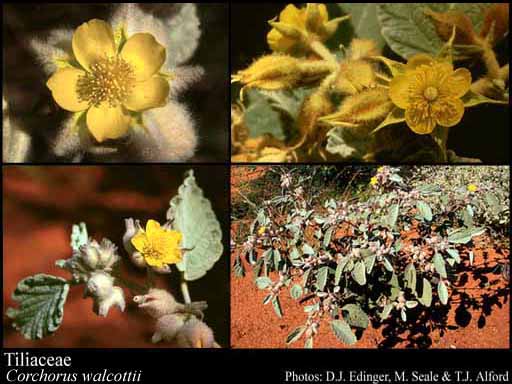This name is not current. Find out more information on related names.
- Reference
- Gen.Pl. [Jussieu] 289 (1789)
- Name Status
- Not Current

Scientific Description
Common name. Linden Family.
Habit and leaf form. Trees and shrubs, or herbs (rarely); leptocaul. Mesophytic. Leaves alternate; spiral, or distichous (or two ranked on the upper half of the shoot); petiolate; non-sheathing; simple. Leaf blades dissected, or entire; conspicuously asymmetric (commonly), or not conspicuously asymmetric; when dissected, palmately lobed; usually palmately veined. Leaves with stipules. Stipules intrapetiolar; free of one another; caducous (often), or persistent. Leaves without a persistent basal meristem. Domatia recorded (9 genera); represented by hair tufts (nearly always), or pockets (rarely). Stem anatomy. Nodes tri-lacunar. Secondary thickening developing from a conventional cambial ring.
Reproductive type, pollination. Fertile flowers hermaphrodite, or functionally male and functionally female, or hermaphrodite, functionally male, and functionally female. Unisexual flowers present, or absent. Plants hermaphrodite, or monoecious, or polygamomonoecious.
Inflorescence and flower features. Flowers solitary, or aggregated in ‘inflorescences’ (sometimes paired); in cymes. The terminal inflorescence unit cymose. Inflorescences cymes, often very complex. Flowers regular; (3–)5 merous; cyclic, or partially acyclic. Sometimes the androecium acyclic. Floral receptacle developing an androphore, or with neither androphore nor gynophore. Free hypanthium absent. Hypogynous disk absent. Perianth with distinct calyx and corolla, or sepaline (corolla rarely lacking); (4–)5–10; 2 -whorled (usually), or 1 -whorled; isomerous (usually). Calyx (3–)5; 1 -whorled; polysepalous, or gamosepalous (sometimes basally connate); imbricate; regular. Epicalyx present, or absent. Corolla normally (4–)5; 1 -whorled; polypetalous; imbricate, or contorted; regular. Corolla members deeply bifid, or entire. Fertile stamens present, or absent. Androecium (10–)15–100 (usually ‘many’). Androecial members branched; maturing centrifugally; free of the perianth (inserted at the base of the petals, or on an androphore); free of one another, or coherent; when coherent 1 - adelphous, or 5 - adelphous, or 10 - adelphous; 1–10 -whorled (or acyclic and covering an androphore). Androecium exclusively of fertile stamens, or including staminodes. Staminodes when present, 5–15; non-petaloid. Stamens (10–)15–100 (usually ‘many’); diplostemonous (rarely), or triplostemonous to polystemonous. Anthers dehiscing via pores, or dehiscing via short slits, or dehiscing via longitudinal slits; bilocular (by contrast with Malvaceae); bisporangiate. Fertile gynoecium present, or absent. Gynoecium 2–100 carpelled (to ‘many’). The pistil 1–100 celled (to ‘many’). Carpels isomerous with the perianth, or reduced in number relative to the perianth, or increased in number relative to the perianth. Gynoecium syncarpous; eu-syncarpous; superior, or inferior (Neotessmannia). Ovary unilocular, or plurilocular; 1 locular (the septa incomplete), or 2–100 locular (to ‘many’). Gynoecium stylate. Styles 1; apical. Stigmas 1; capitate (or lobed); dry type; papillate; Group II type. Placentation when unilocular (i.e. rarely), free central; usually axile. Ovules in the single cavity when unilocular, 2–100 (to ‘many’); (1–)2–50 per locule (to ‘many’); ascending (usually), or pendulous; apotropous; with ventral raphe, or with lateral raphe; arillate (sometimes), or non-arillate; hemianatropous to anatropous.
Fruit and seed features. Fruit fleshy, or non-fleshy; dehiscent, or indehiscent, or a schizocarp. Seeds endospermic. Endosperm oily. Cotyledons 2. Embryo chlorophyllous (4/8); straight, or bent. Micropyle zigzag. Seedling. Germination phanerocotylar.
Physiology, biochemistry. Aluminium accumulation not found. Photosynthetic pathway: C3.
Geography, cytology, number of species. World distribution: cosmopolitan, except for frigid regions. X = 7–41. 450 species.
Economic uses, etc. Tilia supplies lumber (basswood, whitewood), also ornamental and shade trees popular for street plantings.
Keys
Western Australian Genera and Families of Flowering Plants — an interactive key
T.D. Macfarlane, L. Watson, N.G. Marchant